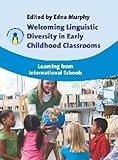Welcoming Linguistic Diversity in Early Childhood Classrooms : Learning from International Schools / ed. by Edna Murphy.
Material type: TextSeries: Parents' and Teachers' GuidesPublisher: Bristol ; Blue Ridge Summit : Multilingual Matters, [2011]Copyright date: ©2011Description: 1 online resource (256 p.)Content type:
TextSeries: Parents' and Teachers' GuidesPublisher: Bristol ; Blue Ridge Summit : Multilingual Matters, [2011]Copyright date: ©2011Description: 1 online resource (256 p.)Content type: - 9781847693471
- 9781847693488
- 372.6 22
- LB1139.5.L35 W35 2011
- LB1139.5.L35 W35 2011
- online - DeGruyter
| Item type | Current library | Call number | URL | Status | Notes | Barcode | |
|---|---|---|---|---|---|---|---|
 eBook
eBook
|
Biblioteca "Angelicum" Pont. Univ. S.Tommaso d'Aquino Nuvola online | online - DeGruyter (Browse shelf(Opens below)) | Online access | Not for loan (Accesso limitato) | Accesso per gli utenti autorizzati / Access for authorized users | (dgr)9781847693488 |
Frontmatter -- Contents -- Preface -- Introduction -- Section 1 -- Chapter 1. Young Children Have Stories to Share -- Chapter 2. Using Multilingual Strategies in Monolingual Early Childhood Classrooms -- Chapter 3. A Year with Five Beginners: Excerpts from the Journal of a First-Grade Teacher -- Chapter 4. Developing the Basic English Language Skills of Young Children in a Linguistically Diverse Classroom -- Chapter 5. An International School Celebrates its Diversity -- Chapter 6. An Amazing Journey: Making English Language Learners Successful -- Chapter 7. The Importance of Maintaining Mother Tongue and Culture in the Classroom -- Section 2 -- Chapter 8. Young Mathematicians: Global Learners -- Chapter 9. Meeting the Needs of Young Second-Language Learners who Struggle -- Chapter 10. The Benefi ts of Sign Language in the International Preschool Curriculum -- Chapter 11. Addressing Transition and Mobility Issues with English Language Learners in the Early Childhood Years -- Chapter 12. Music: The Universal Language -- Chapter 13. Italiano Sì! Sì!: Teaching Italian through PE -- Chapter 14. The Role of the Library in Supporting Young Language Learners and their Families -- Chapter 15. Breaking the Silence: One School’s Solution to a Noncommunicative Class -- Chapter 16. Library Programming for Young English Language Learners -- Section 3 -- Chapter 17. Listening to Parents: Acknowledging the Range of Linguistic and Cultural Experience in an Early Childhood Classroom -- Chapter 18. Writing and Implementing a Language Policy in the Primary Section of a Linguistically Diverse School -- Chapter 19. Maintaining Mother Tongue and Home Culture in a Child’s School Experience -- Chapter 20. Joining the Mother-Tongue Conversation from an Administrator’s Perspective -- Chapter 21. Native Languages and the International Baccalaureate -- Chapter 22. If You Ask a Silly Question You Sometimes Get a Serious Answer
restricted access online access with authorization star
http://purl.org/coar/access_right/c_16ec
Teachers in multilingual classrooms have been working for some years to improve their repertoire of ways to address the needs of very young children who enter school not speaking the language of instruction. The work of 22 seasoned teachers and administrators in international schools all over the world, this book contains a wealth of information for classroom teachers, enabling them to face a new school year with confidence, and for administrators to understand more clearly what is involved in the teaching of young children who do not yet understand the school’s language. Written by teachers well experienced in addressing the needs of this young and vulnerable group, this book will come as a boon to new teachers presented with a multilingual classroom for the first time.
Mode of access: Internet via World Wide Web.
In English.
Description based on online resource; title from PDF title page (publisher's Web site, viewed 01. Dez 2022)


